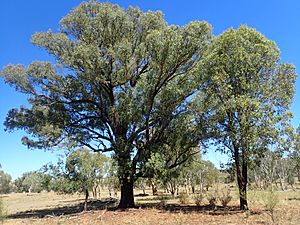Caley's ironbark facts for kids
Quick facts for kids Caley's ironbark |
|
|---|---|
 |
|
| Mature E. caleyi near Bundarra | |
| Scientific classification | |
| Genus: |
Eucalyptus
|
| Species: |
caleyi
|
Caley's ironbark, also known as Ovenden's ironbark, is a special tree found only in eastern Australia. It's a small to medium-sized tree. You can spot it by its rough, brown or black bark, which looks like iron! This bark covers its trunk and main branches.
Its leaves are a dull bluish-grey. They can be shaped like a spear or an egg. The tree's flower buds grow in groups of seven. When they open, you'll see pretty white flowers. Later, these turn into barrel-shaped or cone-shaped fruits.
You'll find Caley's ironbark growing in the Central and Northern Tablelands of New South Wales. It also grows in the south-eastern part of Queensland.
Contents
What Does Caley's Ironbark Look Like?
Caley's ironbark trees usually grow to be about 25 to 30 metres (82 to 98 feet) tall. They have rough, grey, brown, or black bark that feels like "ironbark" on their trunk and branches.
Leaves and Flowers
Young plants and new shoots have bluish-grey leaves. These leaves can be egg-shaped, triangular, or almost round. They are about 30 to 70 mm (1.2 to 2.8 inches) long and 17 to 70 mm (0.7 to 2.8 inches) wide. They also have a small stalk called a petiole.
Adult leaves are a dull bluish-grey on both sides. Sometimes, they might look a bit powdery. These leaves are shaped like an egg or a spear. They measure about 45 to 110 mm (1.8 to 4.3 inches) long and 18 to 45 mm (0.7 to 1.8 inches) wide. Their petioles are 10 to 20 mm (0.4 to 0.8 inches) long.
The tree's flower buds grow in groups of seven. Each group is on a stalk called a peduncle, which is 9 to 20 mm (0.4 to 0.8 inches) long. Each individual bud has its own small stalk, called a pedicel, about 5 to 12 mm (0.2 to 0.5 inches) long.
Mature buds are oval or diamond-shaped. They are 7 to 10 mm (0.3 to 0.4 inches) long and 4 to 5 mm (0.16 to 0.20 inches) wide. The cap of the bud, called an operculum, is cone-shaped. It is 3 to 4 mm (0.12 to 0.16 inches) long and 4 to 5 mm (0.16 to 0.20 inches) wide.
Caley's ironbark mainly flowers between September and November. Its flowers are white.
Fruit
After flowering, the tree produces woody fruits. These fruits are shaped like a barrel or a cone. They are 6 to 10 mm (0.24 to 0.39 inches) long and 4 to 8 mm (0.16 to 0.31 inches) wide. Each fruit sits on a pedicel that is 5 to 14 mm (0.2 to 0.6 inches) long.
How Was Caley's Ironbark Named?
The Caley's ironbark was first officially described in 1906. This was done by a person named Joseph Maiden. He wrote about it in his book, The Forest Flora of New South Wales.
Different Types of Caley's Ironbark
In 1991, two botanists, Lawrie Johnson and Ken Hill, found two slightly different types of this tree. They called these "subspecies":
- Eucalyptus caleyi subsp. caleyi: This type has round fruits.
- Eucalyptus caleyi subsp. ovendenii: This type has fruits that are more square-shaped.
The name caleyi honors George Caley. He was a plant collector. The name ovendenii honors Peter John Ovenden. He was a forester who first noticed the square-fruited subspecies.
Where Does Caley's Ironbark Grow?
Caley's ironbark grows in dry forests and woodlands. You can find it on low hills, ridges, and wide, gently rolling valleys.
It grows from near Denman and the Goulburn River in New South Wales. Its range extends north to the Millmerran area in south-eastern Queensland.
The Ovenden's ironbark subspecies (ovendenii) is found in higher places. It grows to the west of Tenterfield in New South Wales.
Images for kids





